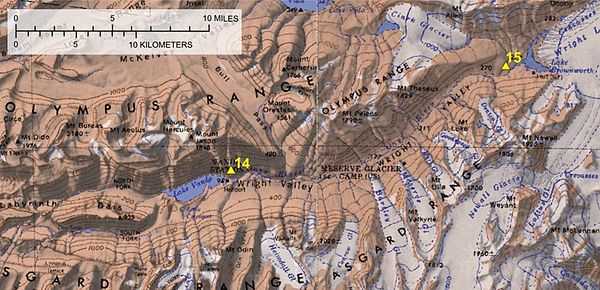Wright Valley
| Wright Valley | |
|---|---|
|
View west towards Lake Vanda and Dais from the foot of Bull Pass. | |
 Map of Wright Valley with Onyx River and Lake Vanda. | |
| Location | Antarctica |
| Geography | |
| Population centers | Vanda Station |
| Watercourses | Onyx River |
The Wright Valley, named for Sir Charles Wright, is the central one of the three large Dry Valleys in the Transantarctic Mountains, located west of McMurdo Sound at approximately 77°10′S 161°50′E / 77.167°S 161.833°E. Wright Valley contains the Onyx River, the largest river in Antarctica, Lake Brownworth, the origin of Onyx River, and Lake Vanda, which is fed by the Onyx River. Its southwestern branch, South Fork, is the location of Don Juan Pond. The upland area known as the Labyrinth is at the valley's west end.
Although portions of the interconnected valley system were discovered in 1903 by the Discovery expedition led by Captain Scott, the Wright Valley located near the centre of the system was not seen until aerial photographs of the region were made in 1947.[1] By the mid 1960s scientists were becoming increasingly intrigued by the paradoxical fact that the valley lay immediately adjacent to the permanent East Antarctic Ice Sheet, yet had remained ice-free for at least thousands of years.[2] Furthermore, Lake Vanda, fed by summer melt water from the Onyx River, maintained impossibly warm water at its deepest point. Although covered by roughly 3 metres (9.8 ft) of ice year-round, lake temperatures of 25 °C (77 °F) had been reliably measured at a depth of 65 metres (213 ft).[3] The lack of snow, warm lake temperatures, unusual rock features, desiccated seal carcasses, and an almost complete lack of plant life invited closer investigation.
Increasing summer field activity and a clear need to establish a winter record led New Zealand's Antarctic Division and the National Science Foundation of the United States to plan a more permanent base in the Valley. In 1968 New Zealand established Vanda Station near the eastern end of Lake Vanda.
See also
- Victoria Valley (north)
- Taylor Valley (south)
References
- ↑ Harrowfield, David L., 2005: Vanda Station, History of an Antarctic Outpost. New Zealand Antarctic Society. ISBN 0-473-06467-7.
- ↑
- McKelvey, B. C., and P. N. Webb, 1962: "Geological investigations in southern Victoria Land, Antarctica, 3, Geology of the Wright Valley." New Zealand Journal of Geology and Geophys. 5, 143-162.
- ↑ Ragotzkie, R. A., and G. Likens, 1964: "The heat balance of two Antarctic lakes." Limnology and Oceanography 9, 412-425
